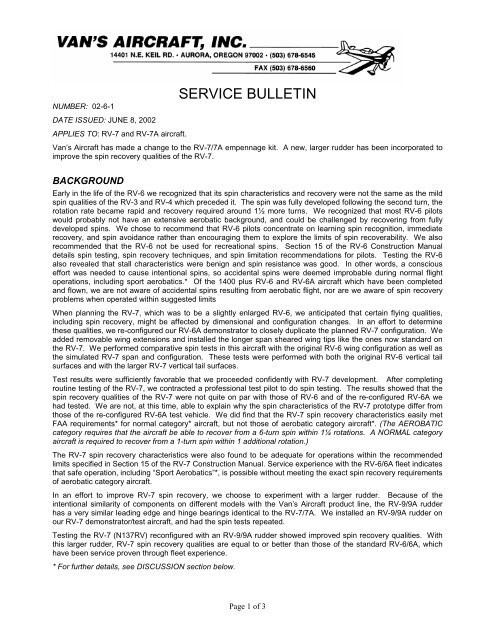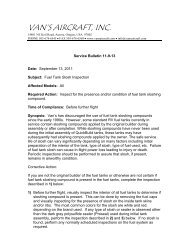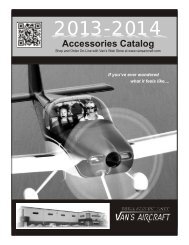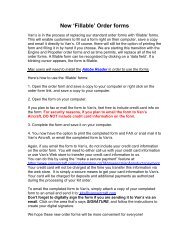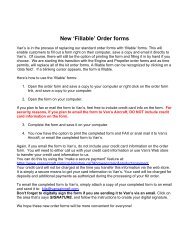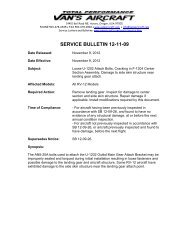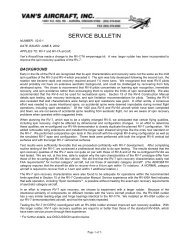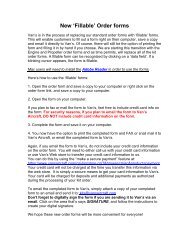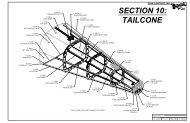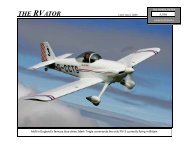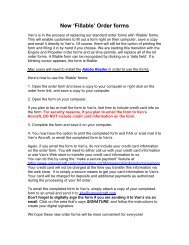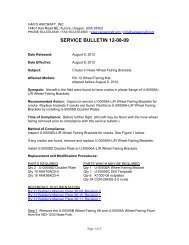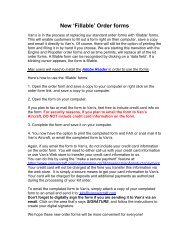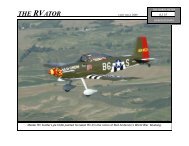SERVICE BULLETIN - Van's Aircraft, Inc.
SERVICE BULLETIN - Van's Aircraft, Inc.
SERVICE BULLETIN - Van's Aircraft, Inc.
Create successful ePaper yourself
Turn your PDF publications into a flip-book with our unique Google optimized e-Paper software.
<strong>SERVICE</strong> <strong>BULLETIN</strong><br />
NUMBER: 02-6-1<br />
DATE ISSUED: JUNE 8, 2002<br />
APPLIES TO: RV-7 and RV-7A aircraft.<br />
Van’s <strong>Aircraft</strong> has made a change to the RV-7/7A empennage kit. A new, larger rudder has been incorporated to<br />
improve the spin recovery qualities of the RV-7.<br />
BACKGROUND<br />
Early in the life of the RV-6 we recognized that its spin characteristics and recovery were not the same as the mild<br />
spin qualities of the RV-3 and RV-4 which preceded it. The spin was fully developed following the second turn, the<br />
rotation rate became rapid and recovery required around 1½ more turns. We recognized that most RV-6 pilots<br />
would probably not have an extensive aerobatic background, and could be challenged by recovering from fully<br />
developed spins. We chose to recommend that RV-6 pilots concentrate on learning spin recognition, immediate<br />
recovery, and spin avoidance rather than encouraging them to explore the limits of spin recoverability. We also<br />
recommended that the RV-6 not be used for recreational spins. Section 15 of the RV-6 Construction Manual<br />
details spin testing, spin recovery techniques, and spin limitation recommendations for pilots. Testing the RV-6<br />
also revealed that stall characteristics were benign and spin resistance was good. In other words, a conscious<br />
effort was needed to cause intentional spins, so accidental spins were deemed improbable during normal flight<br />
operations, including sport aerobatics.* Of the 1400 plus RV-6 and RV-6A aircraft which have been completed<br />
and flown, we are not aware of accidental spins resulting from aerobatic flight, nor are we aware of spin recovery<br />
problems when operated within suggested limits<br />
When planning the RV-7, which was to be a slightly enlarged RV-6, we anticipated that certain flying qualities,<br />
including spin recovery, might be affected by dimensional and configuration changes. In an effort to determine<br />
these qualities, we re-configured our RV-6A demonstrator to closely duplicate the planned RV-7 configuration. We<br />
added removable wing extensions and installed the longer span sheared wing tips like the ones now standard on<br />
the RV-7. We performed comparative spin tests in this aircraft with the original RV-6 wing configuration as well as<br />
the simulated RV-7 span and configuration. These tests were performed with both the original RV-6 vertical tail<br />
surfaces and with the larger RV-7 vertical tail surfaces.<br />
Test results were sufficiently favorable that we proceeded confidently with RV-7 development. After completing<br />
routine testing of the RV-7, we contracted a professional test pilot to do spin testing. The results showed that the<br />
spin recovery qualities of the RV-7 were not quite on par with those of RV-6 and of the re-configured RV-6A we<br />
had tested. We are not, at this time, able to explain why the spin characteristics of the RV-7 prototype differ from<br />
those of the re-configured RV-6A test vehicle. We did find that the RV-7 spin recovery characteristics easily met<br />
FAA requirements* for normal category* aircraft, but not those of aerobatic category aircraft*. (The AEROBATIC<br />
category requires that the aircraft be able to recover from a 6-turn spin within 1¼ rotations. A NORMAL category<br />
aircraft is required to recover from a 1-turn spin within 1 additional rotation.)<br />
The RV-7 spin recovery characteristics were also found to be adequate for operations within the recommended<br />
limits specified in Section 15 of the RV-7 Construction Manual. Service experience with the RV-6/6A fleet indicates<br />
that safe operation, including “Sport Aerobatics”*, is possible without meeting the exact spin recovery requirements<br />
of aerobatic category aircraft.<br />
In an effort to improve RV-7 spin recovery, we choose to experiment with a larger rudder. Because of the<br />
intentional similarity of components on different models with the Van’s <strong>Aircraft</strong> product line, the RV-9/9A rudder<br />
has a very similar leading edge and hinge bearings identical to the RV-7/7A. We installed an RV-9/9A rudder on<br />
our RV-7 demonstrator/test aircraft, and had the spin tests repeated.<br />
Testing the RV-7 (N137RV) reconfigured with an RV-9/9A rudder showed improved spin recovery qualities. With<br />
this larger rudder, RV-7 spin recovery qualities are equal to or better than those of the standard RV-6/6A, which<br />
have been service proven through fleet experience.<br />
* For further details, see DISCUSSION section below.<br />
Page 1 of 3
CONCLUSION:<br />
Flown within the recommended limitations of Section 15 of the Construction Manual, either the original or the<br />
enlarged RV-7 rudder will provide adequate authority for spin recovery.<br />
The substitution of an RV-9 rudder on an RV-7 improved spin recovery. With the larger rudder, the RV-7 will have<br />
better spin recovery from whatever flight condition the pilot may encounter.<br />
IN CONSIDERATION OF THIS, VAN’S AIRCRAFT IS TAKING THE FOLLOWING<br />
ACTION:<br />
1. Van’s <strong>Aircraft</strong> has altered the RV-7/7A Empennage Kit by replacing its rudder with a larger one, identical to the<br />
RV-9/9A rudder. All new kits shipped after 5-20-02 will include the new, larger rudder. The construction plans and<br />
manual included with the RV-7/7A Empennage kits have been altered to reflect the new rudder parts and<br />
assembly procedures. (The rudder details shown on the preview plans show the original rudder configuration and<br />
details, and therefore no longer pertain to the current kit specifications—remember that only the detail shown on<br />
the full size construction drawings supplied with the kit should be used for actual assembly)<br />
Van’s <strong>Aircraft</strong> is offering a no cost replacement rudder kit to all previous RV-7/7A Empennage kit purchasers.<br />
Any owner of an RV-7 kit, may request a new enlarged rudder.<br />
Because of reasonable limits of production capability, Van’s <strong>Aircraft</strong> may not be able to supply rudder<br />
replacements immediately on request. Replacement rudder kits will be prioritized based on the need of the builder<br />
relative to the anticipated completion date of his aircraft.<br />
Van’s <strong>Aircraft</strong> is offering an instrument panel placard for all models which reads:<br />
The purpose of this placard is to make the pilot aware that the Operating Limitations for a specific airplane may<br />
differ from other aircraft of the same model, and that these Operating Limitations are unique to that particular<br />
airplane and were established through its testing.<br />
DISCUSSION:<br />
AEROBATIC LIMITATIONS: Refer to the Operating Limitations for<br />
aerobatic maneuvers permitted in this aircraft.<br />
To gain a Standard airworthiness certificate, an aircraft must demonstrate compliance with the standards of a<br />
given category. The most common categories are Normal, Utility, and Aerobatic.<br />
Experimental Amateur-Built aircraft are not granted standard airworthiness certificates because they have not<br />
shown compliance with any certification standard. Therefore, there are no formal categories, such as Normal and<br />
Aerobatic, for Amateur Built aircraft. With an Experimental Amateur-Built airplane, the OPERATING LIMITATIONS<br />
for each individual airplane either includes or excludes aerobatic maneuvers. The manufacturer (builder) of each<br />
individual Experimental Amateur-Built airplane may request the inclusion of certain aerobatic maneuvers based<br />
solely on his statement of having demonstrated these maneuvers during the aircraft’s flight test phase. A<br />
demonstration of compliance with any standard is not required.<br />
Any statement of design or performance capability made for a certain aircraft design by its kit supplier has no<br />
direct bearing on any particular example of that design when built and licensed by an individual builder. Because<br />
no Experimental Amateur-Built airplane has been assembled to a uniform standard on a production line and under<br />
a quality control program, it cannot be assumed to be identical in performance, handling, and stability as the kit<br />
manufacturer’s prototype.<br />
A prudent builder of a Kit Amateur-Built aircraft should assume that his carefully built example of this aircraft<br />
design will be similar to, but not better than, the factory prototype. Each builder should test and fly his aircraft to<br />
determine its similarity to or differences from the factory specifications. Regarding spin recovery qualities, the<br />
prudent builder will not test his aircraft beyond those limits suggested by the kit manufacturer.<br />
Page 2 of 3
Accidental spins and spin recovery have long been a troubling aspect of aircraft design, and after almost a century<br />
of flight, spins are still widely misunderstood. All spins are not alike. The stability of any airplane varies with its<br />
Center of Gravity position and other factors such as the amount of fuel in wing tanks. This is the reason why many<br />
aircraft have multiple C.G. limits; one for normal flying and another for Aerobatic flying. Minor differences in the<br />
aerodynamic profile of an aircraft can also have an effect on spin characteristics. One simple and commonly<br />
applied modification which is likely to impact spin recovery qualities is the use of wide gear leg fairings (wider than<br />
supplied by Van’s <strong>Aircraft</strong>) on the nose gear leg, or the main gear legs of the tail wheel RV-7. Wider (than supplied<br />
by Van’s <strong>Aircraft</strong>) gear leg fairings add to the overall side area of the airplane, and any side area which is forward<br />
of the center of pressure of the airplane has a directionally destabilizing effect and has been shown to degrade<br />
spin recovery characteristics.<br />
In addition to the variable effects of an aircraft’s weight and C.G., it is difficult to be totally objective in any<br />
discussion of spin and spin recovery characteristics because of the “Pilot skill” factor. Any discussion presupposes<br />
a certain level of pilot competence relative to recognition, response, and application of proper procedures and<br />
technique for spin recovery. Thus, not all spin entries and recoveries are identical.<br />
Accidental spins, in any aircraft, are encountered at airspeeds at or near stall speed. Thus, the flight conditions in<br />
which accidental spins are most likely are take offs, departures, landing approaches, and certain aerobatic flight<br />
attitudes. Because of the unusual attitudes and rapid speed changes associated with aerobatic flying, this flight<br />
regime might be viewed as the most probable opportunity for encountering accidental spins. However, it is also<br />
true that while performing intentional aerobatics, pilots are usually conscious of and attentive to the opportunity for<br />
experiencing control loss. On the other hand, pilots flying departures and landing approaches are in “normal”<br />
attitudes and can easily become complacent and distracted from the importance of the need for speed control and<br />
control coordination so stall/spin accidents are unfortunately common in these non-aerobatic flight conditions.<br />
Accidental spins are certainly not found exclusively in aerobatic flight.<br />
In addition, there is a greater opportunity to recover from accidental spins encountered at safe aerobatic altitudes<br />
than for accidental spins encountered at traffic pattern altitude or lower.<br />
The RV-7, like all other RVs before it, exhibits good spin resistance. From our experience, you can expect stalls<br />
performed with coordinated rudder and aileron controls to be recoverable with little or no wing drop or roll.<br />
Moderately un-coordinated stalls will often result in a wing drop of 20-40 degrees as the nose is lowered for<br />
recovery. Stalls performed with full rudder input and sustained full up elevator will result in the initiation of a spin.<br />
If anti-spin control is applied soon after spin entry (within about 90 deg. rotation), recovery is almost immediate.<br />
Within the first full turn of spin rotation, recovery can be accomplished within a quarter turn after the application of<br />
anti-spin control; opposite rudder and neutral elevator. The first turn requires an elapse time of about 3 seconds.<br />
If you count “one thousand, two thousand, three thousand” at a natural speech rate, you will realize that this<br />
represents more than adequate time to stop the spin. If the spin is permitted to progress and develop, recovery<br />
requires more turns and more elapsed time.<br />
The RV-7, like its predecessor the RV-6, are labeled as “Sport Aerobatic” airplanes. “Sport Aerobatic” is not a<br />
formal FAA or industry classification. It is a label Van’s <strong>Aircraft</strong>, <strong>Inc</strong>. chose to help define the intended aerobatic<br />
use limits of these designs. Van’s <strong>Aircraft</strong> has always been sensitive to the implication of the “fully aerobatic” label<br />
often used in general aviation circles. The generic “aerobatic” label applies to aircraft such as the Cessna 150<br />
Aerobat trainer as well as the very dissimilar unlimited aerobatic airshow and competition aerobatic airplanes.<br />
Thus, we feel the need to define the intended limits of our kit aircraft. While the RV-6 and RV-7 kitplanes have<br />
been designed to meet FAA aerobatic strengths of +6Gs and –3Gs, they should not be assumed capable of all<br />
aerobatic maneuvers, and under any weight and C.G. condition. They were designed primarily as sport/cross<br />
country airplanes with sufficient performance and control authority to safely perform basic recreational aerobatic<br />
maneuvers such as loops and rolls. We do not consider aerobatic maneuvers such as high speed multiple snap<br />
rolls and tail slides, which can impose high airframe loads, to meet our definition of Sport Aerobatics. When<br />
establishing Operation Limitations for their aircraft, we suggest that RV builders list the maneuvers which, through<br />
his testing, will be permitted. They might also list maneuvers specifically prohibited, such as Snap Rolls, Tail<br />
Slides, Inverted Flight, Multiple Turn Spins, etc.). Other maneuvers such as inverted flight and hammerhead turns,<br />
may be included or excluded depending on whether the aircraft is equipped with an inverted fuel and oil system.<br />
Page 3 of 3


